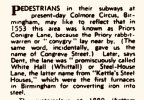I have been aware of these steel making crucibles for some time now. These are adjacent to the Birmingham and Worcester Canal at Kings Norton and it looks like they came from the Kings Norton Metal Works.


There are a few sites around Birmingham where you can see others. By the golf course in Harborne is another location.
I am quite fascinated by the crucible steel making process. Although the Bessemer steel process came about around 1856, crucible steel was still being made till the 1940’s.
A lot of cutting tools were still using crucible steel; crucible steel is quite hard and good for springs.
There is quite an interesting video of the crucible steel making process on You Tube.
Enjoy


There are a few sites around Birmingham where you can see others. By the golf course in Harborne is another location.
I am quite fascinated by the crucible steel making process. Although the Bessemer steel process came about around 1856, crucible steel was still being made till the 1940’s.
A lot of cutting tools were still using crucible steel; crucible steel is quite hard and good for springs.
There is quite an interesting video of the crucible steel making process on You Tube.
Enjoy





